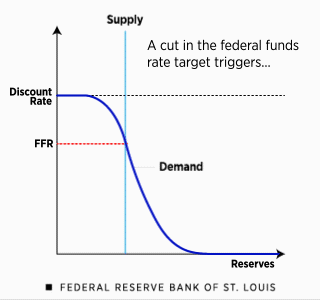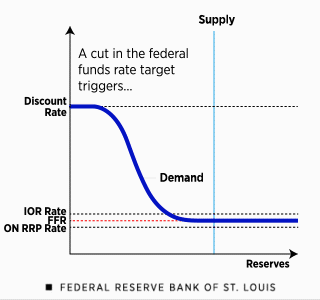How Does the Fed Influence Interest Rates Using Its New Tools?
Do you remember the economics course you took in high school or college? You might recall memorizing the three tools of monetary policy that help the Federal Reserve achieve its congressional mandate of maximum employment and price stability.
The story went something like this: The Federal Open Market Committee (FOMC), which is the main policymaking body of the Fed, sets a desired target for the federal funds rate (FFR) to move the economy toward the dual mandate. The Fed uses its monetary policy tools to influence the supply of money and credit in the economy. It does this primarily by using daily open market operations. When the Fed buys or sells U.S. government securities, it increases or decreases the level (or supply) of reserves in the banking system. (Reserves are the cash banks hold in their vaults plus the deposits they maintain at Federal Reserve banks, and reserves influence the supply of money and credit in the economy.)
Your textbook might have had a graph like the one below. In this model of the money market, the Fed could use open market operations — the purchase or sale of U.S. government securities — to shift the supply curve right or left (along the x-axis) and adjust the FFR lower or higher (along the y-axis).
And, your textbook probably mentioned two other tools — the discount rate and reserve requirements — and said that the Fed could increase or decrease either or both of these to influence bank lending, and thereby the growth of the money supply.
In retrospect, we now refer to that model as the “limited reserves” framework. Those are the old days.
A Primary Tool before the Financial Crisis

NOTES: Fed purchases of U.S. government securities would increase the supply of reserves in the banking system, thereby shifting the supply curve to the right and moving the federal funds rate (FFR) lower. In contrast, sales of securities would reduce the supply of reserves, thereby shifting the supply curve to the left and moving the FFR higher.
The Financial Crisis Changed the Fed’s Toolbox
The Great Financial Crisis of 2007-09 changed a lot of things — including the way the Fed implements monetary policy. You see, in response to the financial crisis, the FOMC lowered its target for the federal funds rate to near zero, and increased the level of reserves from around $15 billion (in 2007) to over $2.7 trillion (in late 2014). That increase shifted the supply curve far to the right — to the horizontal part of the demand curve.
At this point, reserves were much more than “limited.” At the peak, people described the quantity of reserves in the banking system as abundant or even super abundant!
With this large quantity of reserves, making minor adjustments to the supply of reserves (shifting slightly to the left or right) would no longer be an effective way to adjust the FFR up or down. And it became clear that as the economy recovered from the financial crisis, the Fed would need to rely on new tools to raise the federal funds rate.
The Fed’s New Monetary Policy Tools
Now, let’s fast-forward to today. The Fed still uses the federal funds rate as its policy rate, but it has decided to keep an “ample” level of reserves in the banking system — meaning having the supply curve always on the flat portion of the demand curve. So, the Fed’s methods for adjusting the FFR have forever changed.
The Fed’s new framework, dubbed the “ample reserves” framework, uses new monetary policy tools to guide the FFR. The key tools are two “administered” rates (i.e., they are interest rates set by the Fed rather than determined in a market) to guide the federal funds rate within the FOMC’s target range:
- Interest on reserves (IOR)
- Overnight reverse repurchase agreement (ON RRP) rate
But let’s not get ahead of ourselves.
Understanding the process starts with understanding what banks do with their cash that they want to have available for short-term needs.
One option for banks is to lend the cash to other banks in the overnight federal funds market and earn the FFR. The FFR is determined between the borrower and lender in the federal funds market, and it also serves as the Fed’s policy rate — the interest rate the Fed targets to communicate and set the stance (position) of monetary policy.
The Primary New Tool: Interest on Reserves
But banks have other options when seeking a return for their cash. They can deposit it into their reserve account at the Fed and earn interest on reserves (IOR). Because IOR offers banks a risk-free option, it serves as a reservation rate — the lowest rate a lender is willing to accept when lending funds.
As a result, the FFR should not fall below the IOR rate. If for some reason the FFR fell below IOR, banks could borrow at the FFR and deposit the reserves at the Fed (earning the IOR rate) to earn a profit. This arbitrage activity should ensure that the FFR won’t fall very far below the IOR rate and links the rates together. Because the IOR rate is an administered rate, the Fed can nudge the level of the market-determined federal funds rate by adjusting the setting of interest on reserves. In the ample reserves framework, IOR is now the primary tool the Fed uses to adjust the FFR.
So, the first new tool, and also the primary tool of monetary policy, is interest on reserves, or IOR.
A New Supplementary Tool: ON RRP Rate
Now, there is a small complication. Not every financial institution that operates in the federal funds market has access to interest on reserves. So, the FFR could fall below the setting of the IOR rate.
To aid in the control of the level of the FFR, the Fed introduced the overnight reverse repurchase agreement (ON RRP) facility to a broad set of financial institutions. When an institution uses the ON RRP facility, it essentially deposits reserves at the Fed overnight, receiving a government security as collateral. The next day the transaction is “unwound” — the Fed buys back the security, and the institution earns the ON RRP rate on the cash it deposited at the Fed.
Because this is a risk-free investment option, the institutions will likely never be willing to lend funds in any market for lower than the ON RRP rate. And, if similar short-term rates fell too far below the ON RRP rate, institutions would borrow at those lower rates and deposit this cash at the ON RRP facility to earn the ON RRP rate.
These forces link the ON RRP rate to other short-term rates, including the FFR. Because many large nonbank financial institutions have access to the Fed’s ON RRP facility and the ON RRP rate is set below the IOR rate, the ON RRP rate serves as a supplementary policy tool and acts like a floor for the FFR.
So, the second new tool, which supplements IOR, is the overnight reverse repurchase agreement (ON RRP) rate.
How Do the Fed’s New Policy Tools Work Together?
The graph below shows how the new tools work. In the ample reserves framework, the Fed moves the federal funds rate up and down by adjusting its administered rates — IOR and ON RRP rates, along with the discount rate (see the table below) — higher and lower.
Key New Tools: IOR and ON RRP Rates

NOTES: The Fed’s primary tool now for moving the federal funds rate (FFR) is interest on reserves (IOR). A supplementary tool is the overnight reverse repurchase agreement (ON RRP) rate. The Fed moves the FFR higher or lower by moving these two administered rates higher or lower; the discount rate is typically adjusted in a similar manner.
By this time, you’ve got it figured out, but let’s be clear: The Fed no longer uses daily open market operations to adjust the federal funds rate.
While open market operations are used to ensure that the level of reserves remains ample, interest on reserves is the primary tool for adjusting the FFR higher and lower. And the ON RRP rate acts as a floor; it is a supplementary tool.
But where does that leave the other tools? The table below identifies the role of the old tools, as well as new tools.
| Tool | Definition | In Practice in the Ample Reserves Framework |
|---|---|---|
| Interest on reserves (IOR) | Interest paid on reserves that banks hold in their accounts at their Federal Reserve bank. | Because banks are unlikely to lend their reserves in the federal funds market for less than they get paid by the Fed, IOR is an effective tool for guiding the FFR. In fact, interest on reserves is the primary tool for moving the FFR within the target range. |
| Overnight reverse repurchase agreement (ON RRP) rate | The interest rate associated with the ON RRP facility, which is an overnight transaction in which the Federal Reserve sells a U.S. government security to an eligible financial institution and simultaneously agrees to buy the security back the next day. | More types of financial institutions can participate in the ON RRP facility than can earn IOR. Because these institutions are unlikely to lend funds for lower than the ON RRP rate, the FFR is unlikely to fall below the ON RRP rate. As such, the ON RRP rate is a supplementary tool for controlling the FFR. Note: The ON RRP facility, which is a standing offer to conduct overnight reverse repurchase agreements with a set of financial institutions, is a special form of an open market operation. |
| Open market operations | The buying and selling of government securities by the Federal Reserve. | Open market operations served as the primary tool of monetary policy prior to the Great Financial Crisis. While daily purchases and sales are no longer used to adjust the supply of reserves and influence the FFR, open market operations are an important tool in today’s framework because purchases are made periodically to ensure that reserves remain ample. |
| Discount rate | The interest rate charged by the Federal Reserve to banks for loans they obtain through the Fed’s discount window. | Because banks are unlikely to borrow at a rate that’s higher than the discount rate, this rate serves as a ceiling for the FFR. Traditionally, the “stigma” of borrowing from the Fed, however, has generally dampened the discount rate’s effectiveness as a ceiling. |
| Reserve requirements | Funds the Federal Reserve requires banks to hold in cash, either in their vaults or on deposit at a Federal Reserve bank. | In the limited reserves framework, reserve requirements played a central role by creating stable demand for reserves. However, in the ample reserves framework, reserve requirements no longer play a significant role in policy implementation. Partly reflecting this fact, the Board of Governors of the Federal Reserve System announced in mid-March that it was reducing reserve requirements to zero, effective March 26, 2020. |
Conclusion
To sum up, the Fed has a congressional mandate of maximum employment and price stability. It has, for decades, used the setting of the FFR to steer market interest rates in a way that households’ and businesses’ spending and investment decisions move the economy toward the Fed’s dual mandate.
But there has been a big change in the tools that the Fed uses to ensure interest rate control. Today, the Fed uses its administered rate of IOR as its primary tool to move market rates up and down. If the economy loses momentum, for example, the FOMC will lower the target for the FFR and the Fed will lower all its administered rates, which include IOR. This lower setting of the administered rates encourages market interest rates to also decline.
Of course, in severe economic downturns, like the one during the COVID-19 pandemic, the Fed can take other actions to support the economy in addition to lowering interest rates. Some of these tools are only used in “unusual and exigent circumstances” and need the approval of the Secretary of Treasury. These tools are the topic of our next blog post.
More to Explore
- Federal Reserve Board of Governors’ Finance and Economics Discussion Series: The Fed’s “Ample Reserves” Approach to Implementing Monetary Policy
- Page One Economics: The Fed’s New Monetary Policy Tools
- FRED Blog: Fixing the “Textbook Lag” with FRED (Part I): Monetary Policy in a World of Ample Reserves
- FRED Blog: Fixing the “Textbook Lag” with FRED (Part II): Monetary Policy in a World of Ample Reserves
This blog explains everyday economics and the Fed, while also spotlighting St. Louis Fed people and programs. Views expressed are not necessarily those of the St. Louis Fed or Federal Reserve System.
Email Us



